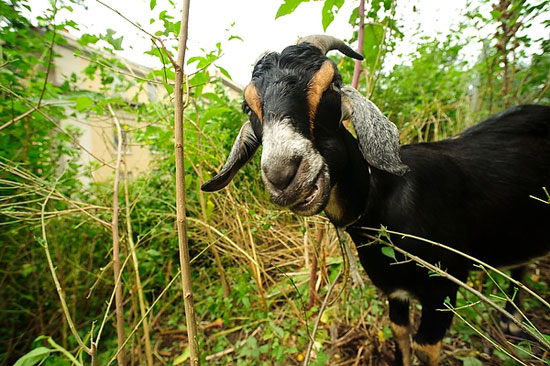Recent Sightings Kids at work: Contractor uses goats to clear hillside

Living Lawnmowers Chomp! More than two dozen goats are helping to remove weeds and brush on the ridge behind the Human Ecology Building on campus this week. A subcontractor working at the site hired the goats through a company in Wisconsin’s Kenosha County that offers a grazing service and promises an “extremely low-carbon hoof print.”
Photo: Bryce Richter
The School of Human Ecology building project on the University of Wisconsin–Madison campus attracted numerous visitors this week, as contractor J.P. Cullen & Sons used goats to clear brush from a steep hillside.
Thirty-two goats from The Green Goats, of Burlington, Wis., chomped tunnels through dense vegetation and walked up to the construction fence to check out the visitors.
J.P. Cullen has never before used goats, and the herd has never before worked in an urban setting.
Shane Swart, a J.P. Cullen site engineer, had seen a Wisconsin State Journal article about a different goat herd helping to restore a Lafayette County prairie, where two graduate students worked on a landscape ecology project with professor John Harrington. Swart wondered whether goats might also work on the human ecology project on Linden Drive. The steep, overgrown hill behind the building was difficult to manage and maintain.
The goats were booked through end of year, but the farmer recommended The Green Goats, owned by farmer Kim Hunter. “I called Kim Monday night,” Swart says. J.P. Cullen approved the project on Tuesday, and the goats arrived on Wednesday. The herd will complete the job on Friday.
Swart says the goats are “more economical by far” than construction workers and gas-powered machinery. When the goats are through, workers will have a clear path to clean up the larger trees and any other remaining plants.
John Wonta, a landscape designer with Ken Saiki Design, Madison, notes the site has “a lot of undesirable species” including black locust, honeysuckle, and buckthorn. After the area is cleared, terracing will decrease the slope, and native canopy trees, fescue lawn mixes, and a mix of native wildflowers and grasses will replace the undesirable plants.
“Buckthorn is a natural food for the goats,” Hunter says. Still, she had some concern about the large amount of pokeweed on the site, as the plant is poisonous to mammals. “Luckily, they don’t touch it.”
The ruminant goats eat for up to an hour, stop to chew their cud, and then return to chomping along the hillside. Inquisitive and friendly, they also sometimes follow visitors along the construction fence, which borders a campus walkway between Agricultural Hall and Van Hise Hall.
Inside the construction site, a temporary electric fence separates the herd from the building itself. There have been no problems using the goats on an urban site, Hunter says. When a generator starts up the goats run off, but they slowly drift back. Other construction noise, the cranes and activity hasn’t bothered them. The herd stays on site at night, and Hunter’s lab/shepherd mix dog is along to help out.
Hunter started her farm three years ago after she moved with her parents from Illinois to six acres in Wisconsin. Hunter got several goats to help clear pasture for her horse, and the next step was her own goat farm.
She now has two herds of mostly Spanish goats, a breed that originally came to North America with the conquistadors. The goats then died out in Europe and became feral and endangered in North America.
The two herds are the Wether Underground — the neutered male herd assigned to the campus project — and the Doe Herd. The latter contains many young goats that are less manageable and unused to getting in and out of a trailer.
Hunter loves the puns and wordplay possible with her kids, and names her goats accordingly. One member of the Wether Underground, for example, is William Ayers, named after the 1960s activist.
Intriguing names aside, the goats enjoy the attention they’ve received on campus.
“We’ve had a lot of visitors,” Swart says. “People are glued to the windows” of the nearby buildings, he adds.
And children are thrilled with the temporary petting zoo.




